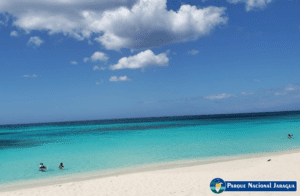
Jaragua National Park is a Caribbean paradise located in the Province of Barahona south of Pedernales, this nature reserve is one of the most important in the Dominican Republic and is part of the first UNESCO Biosphere Reserve in the country.
The 1,295 square kilometers of the Jaragua National Park encompass diverse ecosystems, from the sea to the land, lagoons and islands, Taíno caves, the beautiful and unspoiled Bahía de Las Águilas, and the isolated Beata and Alto Velo islands. The flora and fauna of this area are equal in diversity.
The different species that can be seen in the Jaragua National Park range from manatees to turtles, hawksbills, leatherbacks, loggerheads and green sea turtles, which nest on its beaches. At least 400 species of flora have been identified, including tropical forests, cacti, mangroves and wetlands where more than 130 species of birds live, ten of which are endemic.
You will be able to see large flocks of American flamingos, white crowned pigeons, as well as white ibis, ospreys, gray herons, roseate spoonbills, blue herons, among others. Iguanas also call this park home, from the endangered rhinoceros iguana to Ricord’s iguana. You will also see the Hispaniolan solenodon and the Hispaniolan hutia.

The park represents in a unique and incomparable way the pristine nature of the Antilles, particularly the arid and coastal-marine ecosystems. It contains numerous ecosystems, from different types of natural forests to beaches, rocky shores, wetlands, seagrasses and coral reefs.
Among its marine ecosystems are the largest and best preserved areas of seagrass meadows in the region, which in turn serve as support for endangered animal species and/or species of fishing value, such as the lambí (Strombus gigas) and the spiny lobster (Panulirus argus).
To learn more about other interesting places in the Dominican Republic, follow us at visitadominicana.com
